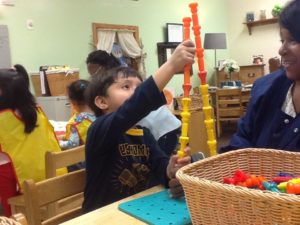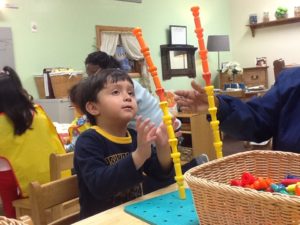Measuring Height With Non Standard Units of Measure
I love these two pictures.
This little boy was trying to figure out if his two towers of pegs were the same height. It was really hard because they were so long that they were bending and curving, so their actual lengths were not readily apparent.
His teacher helped him by holding the base of the towers so he could try and hold them straight and then compare them. She was asking him leading questions that helped him think about how he could compare them, what he wanted her to do to help, and ultimately figure out which one was taller.
At some point, I might have asked him to count the pegs, but that would have been a very difficult task. Using the pegs as a non standard unit of measure, he could have explored how many pegs each tower had and then considered which one had more, which would then mean “taller”. However, one-to-one correspondence is really hard when each unit is attached to another. It is hard to discriminate between the pegs and the colors (it may have been easier if every peg were a different color).
I think he did a great job trying to get them to stand up straight so he could look and see which one was taller. How would you have helped him figure this out?


I agree; love the picture. I would have suggested perhaps laying them down to see which was taller.
I would of had him try laying them down and see which one was longer and that will tell him which one was taller